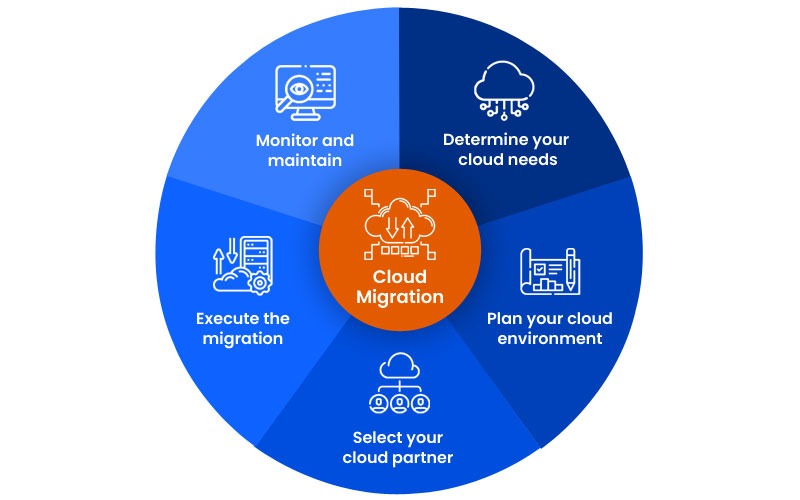Cloud Enablement: Basics and Strategy
As businesses continue to adopt cloud technology rapidly, it is essential to have a robust strategy for cloud enablement. Cloud enablement refers to the process of transforming an organization’s IT infrastructure, applications, and processes to leverage cloud technology fully.

With the right cloud enablement strategy, businesses can optimize their cloud investments, reduce costs, and improve overall efficiency. In this blog, we will discuss in depth how to build an effective and powerful strategy for cloud enablement.
Cloud Enablement
With so much buzz around this word, the question which is most likely to pop up in our heads undoubtedly is, ‘What is cloud enablement?’. Cloud enablement is the process of integrating cloud technology into an organization’s existing IT infrastructure, applications, and operations. It involves identifying and migrating suitable applications to the cloud, optimizing cloud resources to reduce costs, and implementing cloud-native solutions to improve efficiency. With the right cloud enablement strategy, businesses can achieve multifold success
Importance of Cloud Enablement
Cloud technology provides several benefits, including scalability, flexibility, agility, and security. However, businesses must have the right strategy to realize these benefits fully.
Mentioned below are the benefits of cloud enablement
- Cost Savings: Cloud enablement can result in significant cost savings for businesses. By leveraging cloud technology, businesses can eliminate the need for expensive hardware and infrastructure, reduce their capital expenditures, and pay only for the resources they use. Additionally, cloud providers offer economies of scale, making it more cost-effective for businesses to access the latest technology and services.
- Scalability: Cloud enablement allows businesses to scale their resources up or down as needed. This means that businesses can quickly respond to changing business needs, avoid overprovisioning, and pay only for the resources they use. With cloud technology, companies can also scale up quickly to meet unexpected spikes in demand, such as during a product launch or seasonal peak.
- Flexibility: Cloud enablement allows businesses to work from anywhere, anytime. Employees can access the cloud from any device, making working remotely or from different locations more accessible. This can improve work-life balance for employees and enable firms to attract and retain top talent from around the world.
- Agility: Cloud enablement enables businesses to be more agile by providing faster time-to-market, increased innovation, and greater competitiveness. With cloud technology, businesses can quickly spin up new environments, test new ideas, and launch new products and services faster than their competitors.
- Security: A prime Cloud enablement strategy can improve security by providing better data protection, disaster recovery, and backup solutions. Cloud providers have advanced security measures in check, including firewalls, encryption, and multi-factor authentication. Additionally, businesses can implement additional security measures, such as access controls, intrusion detection and prevention, and security monitoring, to protect their data and applications.
- Reliability: Cloud enablement offers a high level of reliability, with cloud providers offering Service Level Agreements (SLAs) that guarantee a level of uptime. This means that businesses can rely on the cloud to deliver consistent performance and availability, reducing the risk of downtime and lost revenue.
- Collaboration: Cloud enablement allows for easier collaboration between employees, partners, and customers. Cloud-based collaboration tools such as Microsoft Teams, Google Meet, and Slack enable real-time collaboration and communication, making it convenient for teams to coordinate and work together regardless of location.
- Sustainability: Cloud enablement can also contribute to sustainability by reducing the carbon footprint associated with running traditional data centers. Cloud providers use energy-efficient data centers and offer carbon offset programs, allowing businesses to reduce their environmental impact. Additionally, cloud technology helps businesses to reduce their paper consumption and travel expenses, further contributing to sustainability efforts.
Steps to Build an Effective Strategy for Cloud Enablement
- Assess Your Current Infrastructure: The first step in building an effective cloud enablement strategy is to assess your current IT infrastructure, applications, and processes. This assessment should include an analysis of your current workloads, infrastructure, and applications to determine which workloads are best suited for the cloud and which are not.
- Determine Your Cloud Goals: The next step is to determine your cloud goals. This involves defining what exactly you want to achieve by moving to the cloud. Your goals may include reducing costs, improving scalability, increasing agility, or improving security.
- Choose the Right Cloud Service Provider: Once you have defined your cloud goals, the next step is to choose the right cloud service provider. You should select a provider that offers the services you need, has a strong track record of reliability, and provides excellent customer support.
- Determine Your Migration Strategy: The next step is to determine your migration strategy. This involves deciding which workloads to migrate to the cloud, the order in which to migrate them, and how to migrate them. It is best to consider whether to use a lift-and-shift or a re-architect approach.
- Optimize Your Cloud Resources: Once you have migrated your workloads to the cloud, the next step is to optimize your cloud resources. This involves monitoring your usage, identifying areas of inefficiency, and implementing measures to reduce costs.
- Implement Cloud-Native Solutions: The final step is to implement cloud-native solutions. This involves taking advantage of the unique capabilities of cloud technology, such as serverless computing, to improve efficiency, scalability, and security.
In addition to the above-mentioned steps, there are a few more things to remember when building a cloud enablement strategy. So let’s take a closer look:
- Security: Cloud security is a critical consideration when building a cloud enablement strategy. The cloud provider you choose should have robust security measures in place, and you should also implement additional security measures to protect your data and applications.
- Governance: Cloud governance involves establishing policies, procedures, and controls to ensure that cloud resources are used appropriately and efficiently. Cloud governance should be part of your cloud enablement strategy from the beginning.
- Training: Cloud technology requires new skills and knowledge. It is essential to invest in training your staff to ensure they have the skills and knowledge necessary to manage cloud resources effectively.
- Monitoring and Management: Monitoring and management are critical to ensure that your cloud resources are performing optimally and to identify and resolve any issues quickly.
- Business Continuity and Disaster Recovery: It is essential to have a fixed plan to ensure business continuity and recovery in the event of a cloud outage or other disruption.
Cloud Enablement Consulting
If you are still determining where to begin with cloud enablement or need more expertise to build a cloud enablement strategy, consider hiring a cloud enablement consulting firm. A cloud enablement consulting firm can help you assess your current infrastructure, determine your cloud goals, choose the right cloud service provider, and develop a migration strategy. They can also help you optimize your cloud resources and implement cloud-native solutions.
Utility of Cloud Technology in making businesses a Global Collaborative Space
Globalization has revolutionized how businesses operate today because of cloud technology. The cloud has enabled companies to access data and applications from anywhere in the world, allowing for increased collaboration. Cloud-based collaboration tools such as Google Drive, Dropbox, and Microsoft Teams have become essential in allowing employees to work together seamlessly on projects, regardless of location.
This level of flexibility and mobility has enabled businesses to operate as a global collaborative space, breaking down geographical barriers and allowing employees to work from anywhere in the world. This not only improves productivity but will enable businesses to tap into a vast global talent pool, expanding their reach and increasing their competitiveness.
Overall, cloud technology has proven to be a key tool for companies looking to thrive in today’s increasingly interconnected world. Furthermore, cloud technology provides greater security and reliability, with built-in data backup and disaster recovery mechanisms. With these benefits, it’s no wonder that more and more businesses are switching to the cloud as a critical component of their operations.
Conclusion
In conclusion, cloud enablement is a critical process that enables businesses to leverage cloud technology fully. Creating an effective and powerful cloud enablement strategy can help companies to achieve greater flexibility and scalability. The steps to building a cloud enablement strategy include assessing your current infrastructure, defining your cloud goals, choosing the right cloud service provider, determining your migration strategy, optimizing your cloud resources, and implementing cloud-native solutions. If you lack the expertise to build a cloud enablement strategy, consider hiring a cloud enablement consulting firm like BuzzyBrains to help you accelerate your cloud migration and optimize your cloud resources.
BuzzyBrains is a leading cloud enablement consulting firm that helps businesses to accelerate their cloud migration and optimize their cloud resources. Our team of experienced cloud experts understands the challenges businesses face in their cloud journey and offers customized solutions to help them achieve their cloud goals.
With BuzzyBrains, you can develop cloud strategies and roadmaps, plan and execute cloud migrations, optimize clouds, secure clouds, and comply with cloud regulations. In addition, our team works closely with clients to understand their unique business needs and tailor their solutions accordingly.
Additionally, we offer ongoing cloud monitoring and management services to help clients optimize their cloud resources and ensure their cloud infrastructure performs at its best. We offer 24/7 support and proactive monitoring to identify and resolve any issues before they impact business operations. With our expertise in cloud strategy, migration, security, compliance, and management, we help businesses achieve their cloud goals faster and more efficiently.
